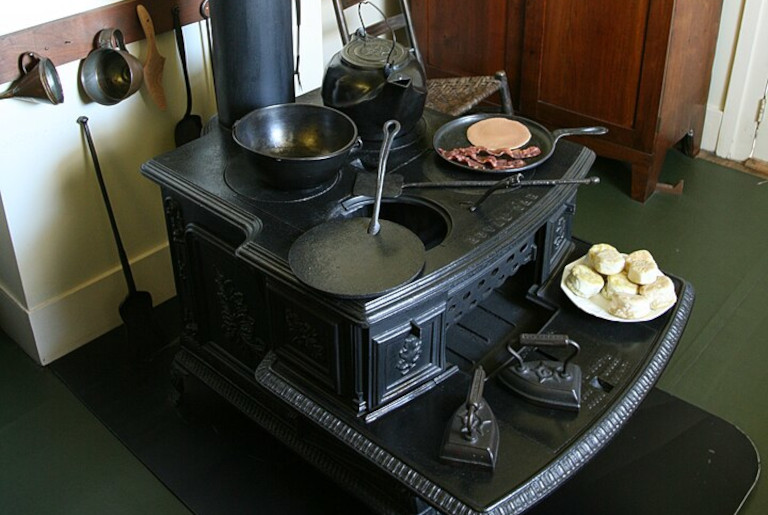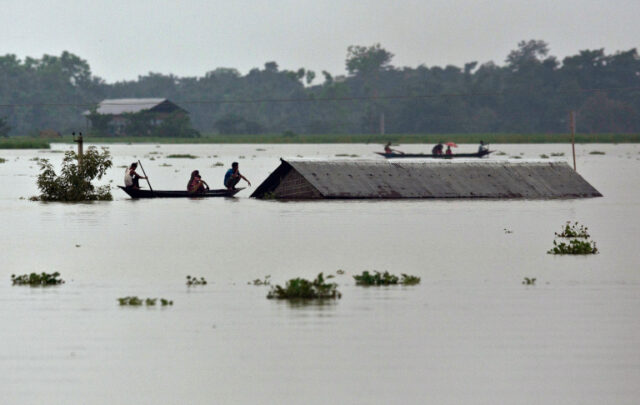Last week, during our very brief flirtation with temperatures above freezing, my coworker announced that he could see his solar panels for the first time since December. Late last fall, he bought a house that has rooftop solar. The roof is pitched to shed snow, but there are just enough little raised edges and crevices in the installation that snow sticks. When there is a heavy fall or new layers added daily, the lowest layers compact and the bottom will melt slightly under the compression. Water will flow out from under the snow even in very cold temperatures. But if it meets with any resistance, it will freeze. Over time, a large dam of ice can build up. (If you live in a cold, wet climate in a house with gutters, you know what that’s like.) Solar panels create many small irregularities in the surface of the roof, and those irregularities are magnified by repeated melt and freeze cycles. In winters like this one, this means that the solar panels are buried under all that dammed snow. (Whichever way you care to spell it…)
My colleague could see the panels. They were not fully, or even mostly, exposed to the sun. And then the next day they were buried again. His house is on net metering, though the former owner took all last summer’s credit with her when she moved. That, combined with extremely low output means he has had a normal electric bill every month. He bought this house with solar installed, so at least he is not paying for the installation — except that the former homeowner undoubtedly wrapped that into the house sale price. So maybe he is not directly paying for the installation. But still, he is paying for it. And he is also paying for electrical generation from Green Mountain Power. He is grumbling about this.
This is not an uncommon story up here. Vermonters were early adopters in the solar transition. Most farms have solar installations, many homes in town do as well despite most of them being rentals. (Many of them had solar panels before being bought as rental properties.) Wind turbines are rather less common here. Turbines are too costly and large for individual homesteads, and Vermont doesn’t really have the wind to drive them. We think a day with sporadic 20mph gusts is unusually windy. Turbines operate most efficiently with constant wind-speeds around 18mph. So, yeah, we don’t have the wind. Green Mountain Power has notably not installed many, though they do have many large solar arrays. However, it is also notable that though they have a mandate to generate clean and renewable electricity, they mostly rely on hydropower. We get more wattage from nuclear energy than solar (not something I’m comfortable with…).
Solar just doesn’t work all that well in Vermont. My colleague’s complaints are common, but there are many other issues at play here. Snow and leaves piling up on the panels are a nuisance, but at least we could do something about that. There are other more intractable things.
For starters, we don’t have that much sun. We are far north and get few hours of sunlight in the winter. We have very few days of unclouded, full sun throughout the year. And we are a mountainous and wooded terrain. What hours of daylight we get are generally shaded. Solar panels only work when the sun is shining on them. There is no solar power at night or if the panel is blocked with leaf and snow, and there is little solar power in cloudy weather and shade. So solar is rather more intermittent here than it normally is. Moreover, they only work optimally in a rather narrow temperature range and, paradoxically, work worse in the heat. So if you install your panels on a south-facing slope in full sun, the panel will probably not work well in the summer either. If the panel is hotter than 95°F, it does not work much at all, and above 120° it will start to break down.
Those output numbers you see when you are shopping for panels were generated under optimum conditions. You can figure on wattage at 50% or less if you have little sun or if you have what is increasingly normal summer temperatures. Vermont probably sees somewhere around 30% of optimal electrical generation. That is my rather sloppy Excel calculation, but it is still a good idea to plan on much reduced efficiency. If five panels will provide the electricity you need in those optimum conditions printed on the manufacturer labels, then you’d best plan on around ten in real world conditions, maybe fifteen in Vermont, ideally spread out so that there are many differently oriented surfaces ready to capture whatever sunlight there is. And even then, there will be many days with no output at all, perhaps much of the winter if you have rooftop solar and no safe way to clean off the snow. That’s a lot of expensive solar panels.
And that brings up another problem for solar in Vermont — the cost. A rooftop solar installation, without batteries and claiming all the clean energy credits available, will cost around $21,000 in Vermont. Add battery storage and you will increase the up-front costs by half again as much. So to have a solar installation that will run your fridge and electric furnace blower at night will cost around $30,000. Vermonters do not have $30,000. Median annual wages in Vermont run around $54,000, and I don’t actually know too many people who make that much. (Averages are pretty much a function of who is reporting the data.) With financing you could pay for that monthly over a period of ten to twenty years (with interest, of course). A twenty-year loan at average interest rates will cost you the most (over double the cost of the panels), but will allow you to pay for it in installments of about $250 a month. A ten-year loan will only add financing charges of half again the cost of the installation, but you’ll need to be paying a bit over $360 a month. For just the installation.
My total energy costs — both electricity and heating fuel — averaged over the year come to about $360 a month, with heating fuel being the higher cost. So to “save money” on this installation, I would need to eliminate all my current energy costs. (If I qualify for financing, which is another kettle of fish…) But obviously, I can’t eliminate all my current energy costs. As we’ve seen above, I would probably have an electric bill most months. Probably every month (there is no way I could get to a rooftop installation on my house to clean it off…). So I would be increasing my costs. Which I could realistically afford. Maybe. Because I live extremely frugally. But most Vermonters do not have that flexibility in their budgeting. (Truthfully, most Vermonters wouldn’t qualify for financing with any responsible lender to begin with.)
But let’s get back to a point alluded to above. I would have to eliminate all my energy costs to save money, or reduce them substantially to even afford it to begin with, never mind savings. But well over half of my energy cost goes not to Green Mountain Power but to heating oil. In fact, I don’t have many energy needs that are not related to heat. And electricity is not the most reliable or effective energy source for generating that heat. I could install full solar and come up with some way to store the energy overnight and keep the panels clear and so on and on and on, and yet I would not have heat in this house. I would only be able to cook when the weather permitted. I would probably have cold water for morning showers after overnight cooling on the tank — unless I try to keep the water heater and the fridge running on battery storage all night. Which is probably not possible. (Don’t even get me started on overnight charging the car…)
But it’s that “no heat in the house” that is the stumbling block. Yes, I could install electric heaters, but that increases the cost up front. I would also need to rewire this house, which might need to happen anyway, just to install the panels to cover the current needs. To add to those needs with electric heat — easily doubling, perhaps tripling, the amount of electrical energy I currently use — would require a full electrical system overhaul. And that’s just the electrical capacity. I’d still need to install the heat source. And that is even more problematic. I do at least have ductwork for a central heat exchanger system, though as pricey as those things are, I just don’t have the money for that. (I don’t know who does… have you seen those price tags!) There are less expensive electrical heaters, but they just don’t fit in this house. I don’t have many walls where a small heat pump or baseboard heater could be installed. There are lots of doors and windows in this building. Plus I live here… there is furniture… baseboard heating works best and safest in empty rooms.
However, it must be said that it doesn’t work well even then. Baseboard heaters are just crappy. Electrical resistance is not a good way to generate heat. Those hot wires are breaking down every time they warm up. Heat pumps work better, but they are still augmenting whatever heat they can pull from the environment (which is not much in Vermont winter) by compressing the air to raise its temperature. This compression is also not good for most physical materials. Things don’t like being squished. They break down.
So what I need from energy really can’t be supplied by electricity. I need heat; I don’t need electricity. I would say most people don’t, if you define need as something you actually require to physically and emotionally thrive. Electrical demands in our culture are largely discretionary. Yes, there is a need for refrigeration for some people. (Diabetics will not survive the power grid collapse…) Lights are sort of necessary if you insist on staying active after dark. Water and air pumps are necessary in many places (though those large buildings that require pumping will probably also not survive the power grid collapse). And then there are all these screens… which are entirely unnecessary, unhealthy even… No, we don’t need electricity. We need heat.
Or cooling, which is its own problem, given that solar panels don’t like to be hot. But even in hot climates, you still need heat for cooking and probably cleaning. You don’t need electricity for much of anything in warm climates. Which is good because in many places with warm climates, electricity is a tenuous thing. Truthfully, electricity is a tenuous thing for most of the world. Only the people who live in wealthy cities, sucking up the material resources of the entire planet, have abundant electrons reliably flowing through their lives.
And that’s another issue… All this is extremely resource intensive. Installing solar panels on my roof is several hundred pounds of stuff that has undergone extraction, shipping, refining, shipping, manufacturing, shipping, sales and installation, probably more shipping. All for one house. That does not need a large amount of electricity. Now, to electrify the world… is, first of all, impossible… much of the world does not live in houses that can be electrified. If you live in a yurt in Central Asia or a stilt-house in the Amazon or a tent in Sudan or any of the billions of improvised shanties around the world, you have maybe one fold-out PV panel. More likely you have a generator. Or fire… But even most of the places that can be electrified would multiply my installation by billions. Moreover, many places don’t have existing infrastructure that is compatible with electrification. My house already has wiring and a connection to Green Mountain Power (which, yes, is not strictly necessary but does smooth out the storage and intermittency issues… much more stuff would be needed to build a self-sufficient system… not that that is possible in Vermont… or in much of the world…). This planet doesn’t have enough stuff to do that. I would say it doesn’t even have enough stuff to completely electrify most wealthy urban centers that already have a lot of stuff in place.
Moreover, most of that stuff is poisonous. It is hard on the places where it is extracted, refined and manufactured. It is hard on the people who have to do that labor. It is toxic in your home (yes, a battery is about the most toxic thing we’ve ever invented). And the worst part of all of this is that none of it lasts. It all is trash in the making.
My colleague bought a house with solar panels on the roof. He believes those solar panels are about fifteen years old; they may be older. The average lifespan of a solar panel is about twenty years. A coddled solar panel might live for thirty years. (By definition, Vermont climate conditions do not qualify as coddling…) So in something like five to ten years, he will have a roof covered in dead solar panels, much of which is toxic waste, very little of which is recoverable in any way. He will have a rooftop of trash. And then he must choose between leaving it up there or replacing it. Which will cost him quite a lot of money either way, but replacing it will cost the planet quite a lot of health and vibrancy and stuff.
All those panels will need to be removed, what can be recovered will be, but most of it will be pure waste, shipped off to places like Bangladesh and Egypt where there are already mountains of toxic electronic trash poisoning the earth. Of course, that is given that in five to ten years we still have the capacity to ship bulky things around the world and that Bangladesh is still talking to us and so on. It also is dependent on solar panels still being made and all those supply and labor chains of global shipping. (Or maybe someone in Vermont will start making them… nah…) It also depends on his discretionary income in five to ten years and other, perhaps more pressing, claims on that income, from health care to flood remediation to eggs. (Which are going to be the next currency, you know..)
I would so love to believe that solar panels are the way to stop burning oil. I still feel the draw. (My neighbor cut down the maple tree… now there is sun… hence I know all these facts and numbers today…) But the fundamental problem with solar panels is that they are not meeting a need. They are keeping the electricity flowing. At great cost. And we don’t need electricity. We need heat. We need to keep our bodies warm in cold climates. We need to cook our food. We need hot water for cleaning, and in most places we need boiled water just to drink. Even the turbines that generate electricity need heat. Most power plants are nothing but fancy boilers. But all turbines require materials that are made with high temperature processes. And then there’s shipping which is also all little fires turning gears. Electrical engines may not need fires, but they do need all the materials made with heat, and no electrical engine can supply the torque necessary to ship large volumes of stuff. (Most barely manage to haul their own batteries around.) It all comes back to heat. We don’t need electricity. Not even electricity needs electricity. We need heat.
I am fretting again about heat and the fragility of electrical transmission in New England. When the power lines are knocked down by life, there is no power in my house. Which means there is no heat because there is no blower nor any way to turn on the furnace or regulate the flow of oil from the tank to the burners. I keep trying to figure out how to have reliable heat. And solar panels paired with a heat exchanger might be somewhat reliable. Except it’s not, as we’ve seen… It’s not a good solution for me. But it’s also not that good for the planet.
People in some circles pooh-pooh wood stoves, pointing to the smoke and deforestation that were common in Victorian times and are still a problem wherever there is extraction. But that extraction is the problem! Not wood heat. The problem is taking whatever you can to make a profit and cleaning up none of the mess. Deforestation is not a product of fueling. Most deforestation is and always has been caused by industry, people cutting down trees for paper pulp, for building materials, for ship masts, or just because the trees are in the way of some profit-seeking scheme. Deforestation is extraction. Fueling is the opposite of that. People don’t destroy their fuel source unless they are given no options. We have been burning things for hundreds of thousands of years. Only in a few abnormal places have we turned forests into barren wastelands, and all of those were driven by wealth extraction to feed hierarchies. In any case, it is perfectly possible to coppice a woodlot more or less indefinitely, supplying ample fuel for a community, while nurturing whatever other life is happening in those woods.
As to the smoke, yes, that is a problem — if you burn green wood in an open hearth, generating little heat and a lot of mess. If you age your wood until it is dry and burn it in a modern stove, the emissions are negligible. My Hearthstone wood stove in my Massachusetts farmhouse burned aged maple and oak so cleanly and completely, I only emptied ash a few times each burn season, and you could never tell when it was burning by looking at the chimney. No smoke. No lost heat either. Snow could pile up around the masonry. (Which was not good… but still…) I should say that I heated a 3000-square-foot 18th-century farmhouse with mainly just that one stove and 4 cords of wood a year. (Which for you data nerds is about four 18-inch diameter trees, mostly hardwood.)
I need to heat a home. I need, at a minimum, to keep the pipes in the walls from freezing even when it is below zero outside. If I lived further south, I might not need as much heat. But I would still need heat more than electricity, and what electricity I used would be mainly intermediary, a way to get to heat, not an end in itself — though I do need light in the evenings (unless I can quit my job, have dinner in the afternoon, and be in bed by dark). The most direct route to heat is also the least toxic, most reliable, most durable, and most sustainable within Vermont — and that’s heating with wood. Solar panels undoubtedly work elsewhere (though not quite as long as we’d like them to). But they are little but an ecotopian dream here.
Maybe what I am saying is learn from our mistakes. The early adopters have test run the system and found it somewhat lacking in critical ways. You can’t get heat, but you do get a huge expensive mess. And in a few years all these early adopters are going to have to figure out what to do with the trash. That seems… scary… and stupid…
Particularly when we have all these trees…
And Hearthstone…
©Elizabeth Anker 2025





